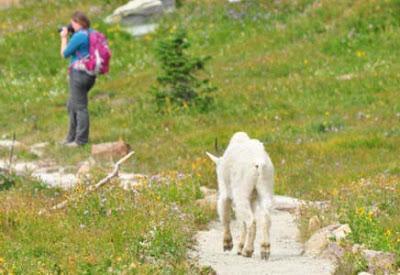
Mountain goat (Oreamnos americanus), Glacier National Park
My friend and fellow children's book author Caroline Hatton and her husband visited Glacier National Park in Montana in August 2017, where, despite less than optimal viewing conditions, they saw lots of wildlife. She took the photos in this post. Caroline's latest book, C'est pas marrant is in her native French, for ages 8 and up. It's about humorous sibling antics in Paris. Here's her report of her trip to Glacier NP.
It was supposed to be a vacation, a break from L.A. smog and traffic. Not!
As we arrived at Glacier National Park, evening winds stretched a thick blanket of wildfire smoke over the Rocky Mountains,* the brownish haze blurring the ridges visible from our cabin at Rising Sun.The next morning, a Sunday, the cold air smelled smoky and the closest peak had a faint, sickly purplish tinge. The mountainscapes looked jaundiced and washed out like watercolors by an art class drop-out.To reduce pollution and enjoy sightseeing without concern about driving and parking, we left our rental car at the St Mary Visitor Center, at the eastern end of the famous Going-to-the-Sun Road, and rode the park's free shuttle to Logan Pass.A long line of cars and assorted buses approached the pass and the trail up to Hidden Lake looked like an ant hill crawling with tourists.

Columbian ground squirrel (Urocitellus columbianus)
Before hiking to the Hidden Lake Overlook, we squeezed onto a crowded bench for a bite of lunch. I was elbowed by what turned out to be a rude, unshaved, local resident (a Columbian ground squirrel), who proceeded to stare at me and inspect my day pack without permission.I thumped my boot but he didn't even blink. To keep him from chewing a hole in my pack, I had to yank it away. He had targeted the corner, inside which were Planters Dry Roasted Peanuts, an unexpected sign of good taste in an otherwise uncivilized individual.
Hoary marmot (Marmota caligata), total length 2 feet ~ 60 cm or more

Seriously: not reckless, but cautious trio of bighorn sheep (Ovis canadensis)
Farther uphill, a reckless trio (three bighorn sheep) raced across the trail with no warning, between oncoming groups of hikers. It looked like a collision begging to happen. In L.A., they'd put up some kind of sign, such as those that say, "CAUTION: truck crossing!"
Slow traffic: mountain goat
Also in L.A., they have freeway signs that say, "Slower traffic: keep right."Oh well. At least we got our money's worth, because obviously, we weren't in L.A.!
We did not hike from the Hidden Lake Overlook down to Hidden Lake because climbing back up would have required deep breathing, which didn’t seem like a good idea in the smoky air. Vistas remained hazy every one of the eight days we spent between Glacier National Park and the adjacent Waterton Lakes National Park in Alberta, Canada, but we were lucky to see one black bear, two moose, four grizzlies, a dozen deer, lots of squirrels and chipmunks, and many, many more bighorn sheep in several different locations.All the shuttle drivers we encountered during our visit were highly professional, helpful, and friendly. They said that the park was usually much more crowded on weekends days than week days. At each stop, they radioed to the dispatcher the number of people waiting for rides in each direction, if any, for faster service.
We’d love to go back to Glacier National Park in other seasons!
Update as of September 1, 2017:
Since we came home from Glacier, they closed the lodge at Lake McDonald one month early due to concern for the health of the staff, who had been exposed daily to smoke from the nearby Sprague Fire. All trails around and from Lake McDonald had been closed since the fire. Then that fire grew a little larger. Now it has destroyed this historic chalet. What a sad day for the park and all who have enjoyed staying at the lodge through the years.

Hungry marmot
Footnotes* Ten days before our arrival, a thunderstorm had generated some 150 lightning strikes, some of which started three wildfires in the park, including near the western end of the Going-to-the-Sun Road. More wildfires had already been burning or started burning afterwards outside of the western boundary of the park.Fire is a natural process that improves habitat for many wildlife species and maintains certain forest types. In Glacier National Park, fires burn every year. Unless they threaten structures, fires are allowed to run their natural course as an integral part of managing ecosystems. Wildfires that start in summer may burn until snow falls.** Implying that any marmot was on the trail, let alone that it almost got stepped on, is a grumpy exaggeration. The closest marmot was on the grass next to the boardwalk.
For more info:
For students to learn more about wildfires: Fire-in-Depth by the U.S. National Park Service https://www.nps.gov/fire/wildland-fire/learning-center/fire-in-depth/wildfire-causes.cfm
GLACIER NATIONAL PARK: Hike to Hidden Lake by Tom Scheafferhttps://theintrepidtourist.blogspot.com/2016/07/?m=0
GLACIER NATIONAL PARK, Montana: A Place to Renew Your Spirit by Caroline Arnoldhttps://theintrepidtourist.blogspot.com/2012/10/glacier-national-park-montana-place-to.html
